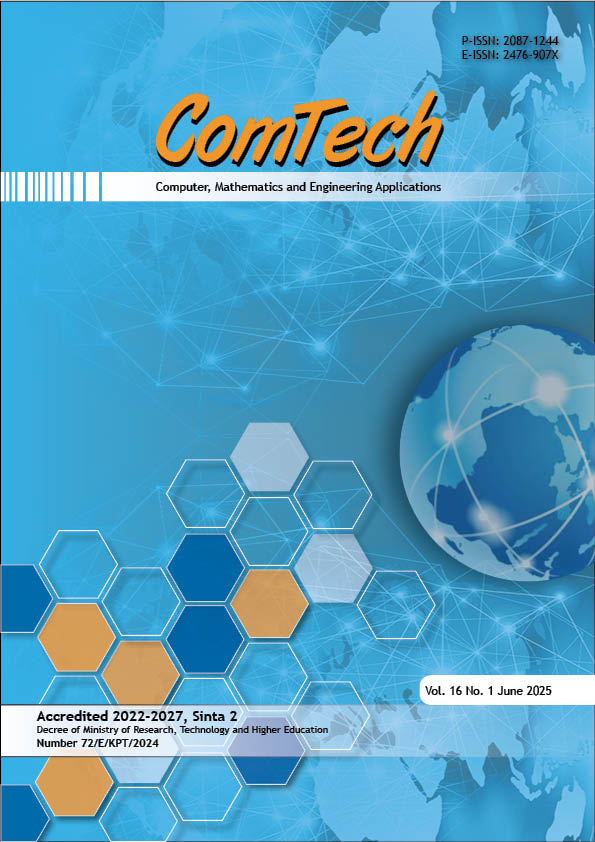Designing School Building Maintenance Priorities Using the Cost-User Effectiveness Ratio
DOI:
https://doi.org/10.21512/comtech.v16i1.12385Keywords:
school building maintenance, Cost-User Effectiveness Ratio (CUER), analytical hierarchy process, prioritization, decision-makingAbstract
Prioritizing school building maintenance solely based on structural damage often leads to inefficient budget allocation and fewer beneficiaries. The research introduced an integrated Cost-User Effectiveness Ratio (CUER) to establish maintenance priorities by combining three critical factors: damage severity, maintenance costs, and the number of affected students. The CUER formulation employed the Geometric Mean or the root mean multiplication of the cost effectiveness and user effectiveness ratio to balance these factors systematically. The methodology encompassed several steps, including damage assessment and calculation of component importance weights using the Analytical Hierarchy Process (AHP), to determine integrated damage levels, costs, and student weights. These inputs were subsequently used to generate priority rankings of schools requiring maintenance. As a result, the case study in Wonogiri Regency illustrates the superiority of the proposed method over the conventional method. While the conventional approach prioritizes 27 schools benefiting 2,442 students, the CUER approach prioritizes 33 schools benefiting 2,957 students, demonstrating increased efficiency and broader impact. The CUER-based model presents a systematic and equitable solution to prioritize school building maintenance, ensuring the optimal allocation of resources and maximizing benefits within existing budgetary constraints. This innovative approach addresses current challenges in maintenance planning and offers significant implications for improving the management of educational infrastructure.
References
Alharasees, O., Kale, U., Rohacs, J., Rohacs, D., Eva, M. E., & Boros, A. (2024). Green building energy: Patents analysis and analytical hierarchy process evaluation. Heliyon, 10(8), 1–22. https://doi.org/10.1016/j.heliyon.2024.e29442
Almohassen, A. S., Alfozan, M., Alshamrani, O. S., & Shaawat, M. E. (2023). Evaluating construction contractors in the pre-tendering stage through an integrated based model. Alexandria Engineering Journal, 82, 437–445. https://doi.org/10.1016/j.aej.2023.09.069
Al-Rahbi, A. K. H., Abushammala, M. F., & Qazi, W. A. (2020). Application of the analytic hierarchy process for management of soil erosion in Oman. International Journal of the Analytic Hierarchy Process, 12(1), 104 – 116. https://doi.org/10.13033/ijahp.v12i1.683
Andal, E. R., & Juanzon, J. B. P. (2020). Identifying risks in implementing sustainable building materials in condominium fit-out projects using analytic hierarchy process. Civil Engineering and Architecture, 8(6), 1266–1276. https://doi.org/10.13189/cea.2020.080610
Aykut, T. (2021). Determination of groundwater potential zones using Geographical Information Systems (GIS) and Analytic Hierarchy Process (AHP) between Edirne-Kalkansogut (Northwestern Turkey). Groundwater for Sustainable Development, 12. https://doi.org/10.1016/j.gsd.2021.100545
Badan Pusat Statistik. (2023). Statistik pendidikan 2023. https://www.bps.go.id/id/publication/2023/11/24/54557f7c1bd32f187f3cdab5/statistik-pendidikan-2023.html
Chundi, V., Raju, S., Waim, A. R., & Swain, S. S. (2022). Priority ranking of road pavements for maintenance using analytical hierarchy process and VIKOR method. Innovative Infrastructure Solutions, 7. https://doi.org/10.1007/s41062-021-00633-7
El Hadidi, O., El‐Dash, K., Besiouny, M., & Meshref, A. (2022). Evaluation of a building Life Cycle Cost (LCC) criteria in Egypt using the Analytic Hierarchy Process (AHP). International Journal of the Analytic Hierarchy Process, 14(2), 1–26. https://doi.org/10.13033/ijahp.v14i2.958
Fernandez, R., Calvo, A., Correal, J. F., D’Ayala, D., & Medaglia, A. L. (2024). Large-scale school building infrastructure improvement: The case of the city of Cali, Colombia. Socio-Economic Planning Sciences, 93, 1–13. https://doi.org/10.1016/j.seps.2024.101881
Gashaw, R., Belay, S., Gizat, A., Hailu, S., Rookoei, S., & Matos, J. (2023). Development of an integrative green building rating system for the Ethiopian public building projects using analytic hierarchy process. Cogent Engineering, 10(2), 1–22. https://doi.org/10.1080/23311916.2023.2283324
Hansen, S., Siregar, P. H., & Jevica. (2020). Analytic hierarchy process-based decision-making framework for formwork system selection by contractors. Journal of Construction in Developing Countries, 25(2), 237–255. https://doi.org/10.21315/JCDC2020.25.2.10
Ibrahim, A. H., & Shaker, M. A. (2019). Sustainability index for highway construction projects. Alexandria Engineering Journal, 58(4), 1399–1411. https://doi.org/10.1016/j.aej.2019.11.011
Ismanto, Harimurti, & Zaika, Y. (2017). Penentuan prioritas kegiatan perawatan bangunan gedung sekolah negeri di Kota Blitar. Rekayasa Sipil, 11(3), 236–244. https://doi.org/10.21776/ub.rekayasasipil/2017.011.03.9
Jayakody, J. A. N. N., Nasvi, M. C. M., Robert, D. J., Navaratnarajah, S. K., Kurukulasuriya, L. C., Giustozzi, F., Gunasekara, C., & Setunge, S. (2024). Development of a cross-asset model for the maintenance of road and water pipe assets using AHP method. Civil Engineering Journal, 10(2), 336–361. http://dx.doi.org/10.28991/CEJ-2024-010-02-01
Le, A. T. H., Domingo, N., Rasheed, E., & Park, K. (2021). Maturity model of building maintenance management for New Zealand’s state schools. Building Research & Information, 50(4), 438–451. https://doi.org/10.1080/09613218.2021.1961573
Kementerian Pendidikan, Kebudayaan, Riset, dan Teknologi. (2022). Peraturan Menteri Pendidikan, Kebudayaan, Riset dan Teknologi Nomor 3 Tahun 2022 tentang Petunjuk Operasional Dana Alokasi Khusus (DAK) Fisik. JDIH BPK. https://peraturan.bpk.go.id/Details/224162/permendikbudriset-no-3-tahun-2022
Kementerian Pendidikan, Kebudayaan, Riset, dan Teknologi. (2023). Buku panduan - Tata cara identifikasi dan verifikasi kerusakan - Cara mengisi form kerusakan untuk sekolah dan madrasah. Dapodik. https://www.dapodik.co.id/2023/04/buku-panduan-tata-cara-identifikasi-dan.html
Menteri Pekerjaan Umum dan Perumahan Rakyat. (2008). Peraturan Menteri Pekerjaan Umum dan Perumahan Rakyat Nomor 24 Tahun 2008 tentang Pedoman Pemeliharaan dan Perawatan Bangunan Gedung. JDIH BPK. https://peraturan.bpk.go.id/Details/104476/permen-pupr-no-24prtm2008-tahun-2008
Mushtaha, E., Shamsuzzaman, M., Abdouli, S. A., Hamdan, S., & Soares, T. G. (2020). Application of the analytic hierarchy process to developing sustainability criteria and assessing heritage and modern buildings in the UAE. Architectural Engineering and Design Management, 16(5), 329–355. https://doi.org/10.1080/17452007.2019.1693335
Nautiyal, A., & Sharma, S. (2022). Scientific approach using AHP to prioritize low volume rural roads for pavement maintenance. Journal of Quality in Maintenance Engineering, 28(2), 411–429. https://doi.org/10.1108/JQME-12-2019-0111
Razi, P. Z., Ali, M. I., & Ramli, N. I. (2019). AHP-based analysis of the risk assessment delay case study of public road construction project: An empirical study. Journal of Engineering Science and Technology, 14(2), 875–891.
Yang, Y., Yu, B., Tai, H., Shen, L., Liu, F., & Wang S. (2022). A methodology for weighting indicators of value assessment of historic building using AHP with experts’ priorities. Journal of Asian Architecture and Building Engineering, 21(5), 1814–1829. https://doi.org/10.1080/13467581.2021.1971529
Wang, Y., Liu, Y., Hong, Q., & He, Q. (2023). Research on low-carbon evaluation of clean energy use in rural residential buildings based on analytic hierarchy process method. Engineering Reports, 6(2), 1–11. https://doi.org/10.1002/eng2.12715
Warnars, H. L. H. S., Kusnadi, E., & Warnars, L. L. H. S. (2021). Prediction of road infrastructure priorities in Banten province using analytical hierarchy process method. International Journal of Engineering Research in Africa, 53, 112–122. https://doi.org/10.4028/www.scientific.net/JERA.53.112
Downloads
Published
How to Cite
Issue
Section
License
Copyright (c) 2025 Visaretri Pramuktia Purwosri, Hari Prasetyo, Mochamad Solikin, Senja Rum Harnaeni, Sri Sunarjono

This work is licensed under a Creative Commons Attribution-ShareAlike 4.0 International License.
Authors who publish with this journal agree to the following terms:
a. Authors retain copyright and grant the journal right of first publication with the work simultaneously licensed under a Creative Commons Attribution License - Share Alike that allows others to share the work with an acknowledgment of the work's authorship and initial publication in this journal.
b. Authors are able to enter into separate, additional contractual arrangements for the non-exclusive distribution of the journal's published version of the work (e.g., post it to an institutional repository or publish it in a book), with an acknowledgment of its initial publication in this journal.
c. Authors are permitted and encouraged to post their work online (e.g., in institutional repositories or on their website) prior to and during the submission process, as it can lead to productive exchanges, as well as earlier and greater citation of published work.
 USER RIGHTS
 All articles published Open Access will be immediately and permanently free for everyone to read and download. We are continuously working with our author communities to select the best choice of license options, currently being defined for this journal as follows:




















